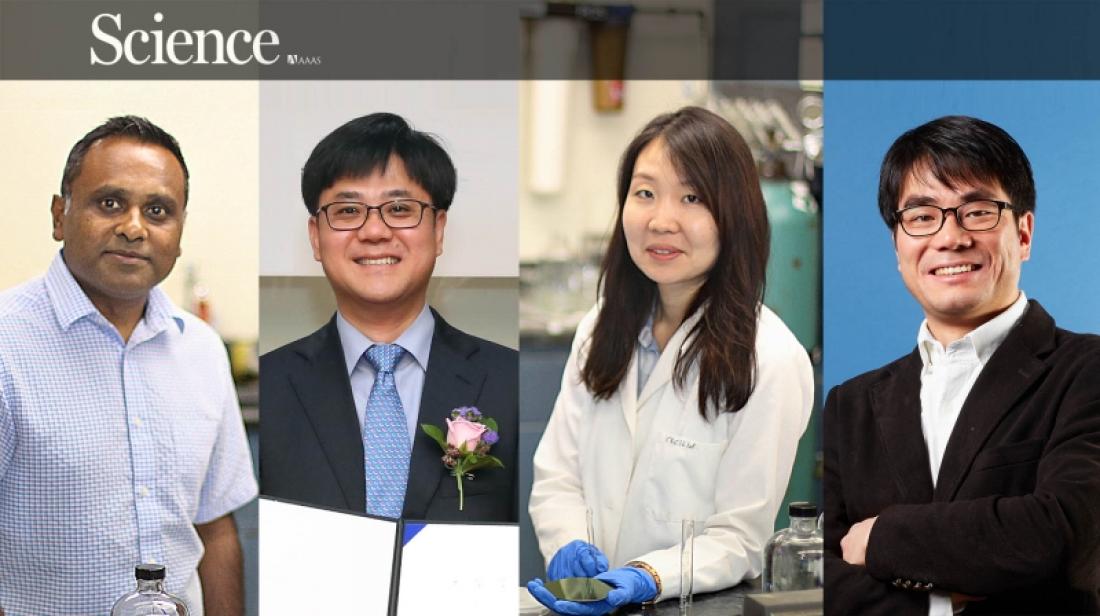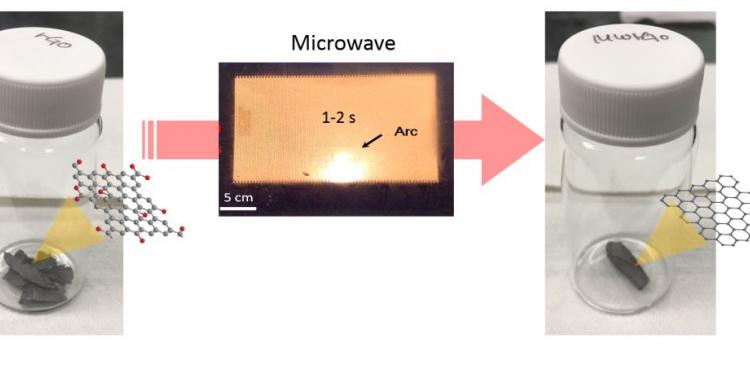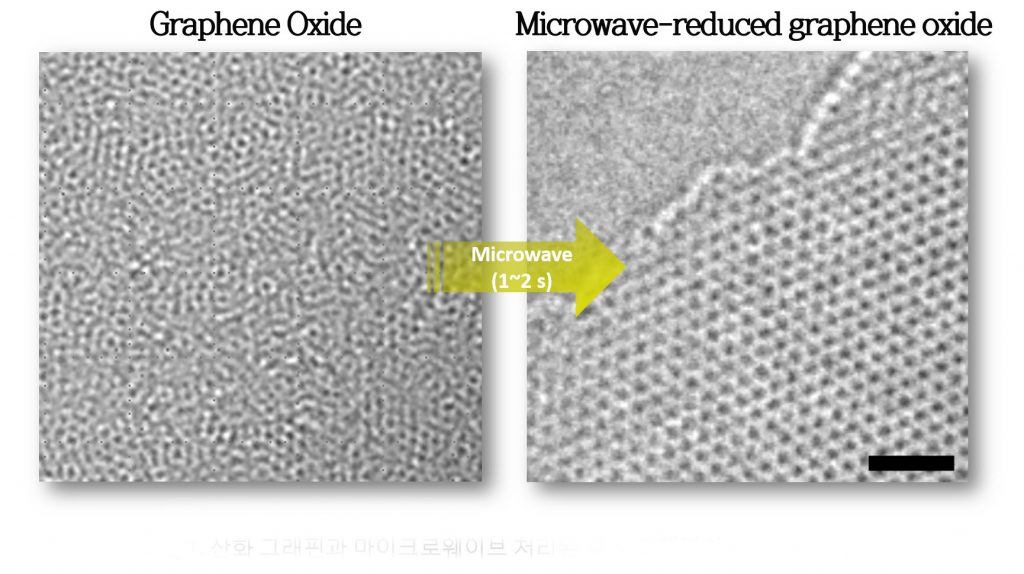From left are Prof. Manish Chhowalla (Rutgers' School of Engineering), Prof. Hyeon Suk Shin (School of Natural Science, UNIST), Dr. Jieun Yang (Rutgers Univ.), and Prof. Hu Young Jeon (School of Natural Science, UNIST).
Graphene, a material that could usher in the next generation of electronic and energy devices, could be closer than ever to mass production, thanks to microwaves.
A new study by an international team of researchers from UNIST and Rutgers University has proved that it is now possible to produce high quality graphene, using a microwave oven. The team reports that this new technique may have solved some of graphene’s difficult manufacturing problems. The findings of the research have been published in the September issue of the prestigious journal Science.
This study was jointly conducted by Dr. Jieun Yang, an alumna of UNIST, Prof. Hyeon Suk Shin (School of Natural Science) of UNIST, Prof. Hu Young Jeon (School of Natural Science) of UNIST, Prof. Manish Chhowalla of Rutgers University, and five other researchers from Rutgers University, New Brunswick, NJ, United States.
Graphene comes from a base material of graphite, the cheap material in the ‘lead’ of pencils. The structure of graphite consists of many flat layers of graphene sheets. One of the most promising ways to achieve large quantities of graphene is to exfoliate graphite into individual graphene sheets by using chemicals. However, the oxygen exposure during the process may cause some inevitable side reactions, as it can ultimately be very damaging to the individual graphene layers.
Indeed, oxygen distorts the pristine atomic structure of graphene and degrades its properties. Therefore, removing oxygen from graphene oxide to obtain high-quality graphene has been a significant challenge over the past two decades for the scientific community working on graphene.
Dr. Yang and her research team have discovered that baking the exfoliated graphene oxide for just 1-to-2 second pulses of microwaves, can eliminate virtually all of the oxygen from graphene oxides.
“The partially reduced graphene oxides absorb microwave energy, produced inside a microwave oven ,” says Dr. Yang, the lead author of the study. She adds, “This not only efficiently eliminates oxygen functional groups from graphene oxides, but is also capable of rearranging defective graphene films.”
The results indicate that the new graphene exibits substantially reduced oxygen concentration of 4% much lower than the currently existing graphene with an oxygen content in the range of 15% to 25%.
Prof. Shin states, “Countries around the world, such as South Korea, U.S., England, and China have been investing heavily in research for the affordable, mass commercialization of graphene.”
He adds, “The current method for mass-producing high-quality graphene lacks reproducibility, but holds huge untapped market potential. Therefore, securing the fundamental technology for mass production of graphene is an extremely important matter in terms of commercializing future promising industries.”
The study’s co-author, Prof. Manish Chhowalla is an associate chair in the Department of Materials Science and Engineering in Rutgers’ School of Engineering and Director of the Rutgers Institute for Advanced Materials, Devices and Nanotechnology. Prof. Chhowalla has been working on a joint research project with Prof. Shin and Prof. Jeon of UNIST. Dr. Jieun Yang, a former student of Prof. Shin is now working as a post-doctoral associate in Chhowalla’s group at Rutgers University.
This work has been supported by the National Science Foundation, Rutgers Energy Institute, U.S. Department of Education and Rutgers Aresty Research Assistant Program.
Journal Reference
Damien Voiry, Jieun Yang, Jacob Kupferberg, Raymond Fullon, Calvin Lee, Hu Young Jeong, Hyeon Suk Shin, and Manish Chhowalla, “High-quality graphene via microwave reduction of solution-exfoliated graphene oxide”, Science, (2016).
BACKGROUND INFORMATION ON DR JIEUN YANG
The story of a Korean female researcher, co-authoring Science journal article has made headlines around the world. Dr. Jieun Yang, an alumna of UNIST is part of an international team that has discovered a simple new method for producing large quantities of the promising nanomaterial graphene. Dr. Yang and colleagues, which include Prof. Hyeon Suk Shin (School of Natural Science, UNIST) and Prof. Hu Young Jeon (UNIST Center for Research Facilities, UNIST), report the discovery in the September issue of the prestigious journal Science.
Dr. Yang was born and brought up in Ulsan, South Korea. After high school, Dr. Yang moved to Seoul, where she completed her undergraduate degree in chemistry at Kyung Hee University. In 2009, she returned to Ulsan to start her PhD under the supervision of Prof. Hyeon Suk Shin at UNIST. Dr. Yang is currently working as a post-doctoral associate in Chhowalla’s group at Rutgers University, New Brunswick, NJ, United States. Her scientific interests are focused on the synthesis, characterization, and application of 2D materials, which include Graphene, h-BN, and MoS2.
Dr. Yang states, “I took the admission test in 2008 before UNIST was even founded,” says Dr. Yang. “Joining UNIST was one of the greatest adventures, yet one of the best decisions I made in my life.”
“Not only was Dr. Yang an excellent and hard-working student, but she was extremely professional in her every day responsibilities,” says her PhD advisor, Prof. Hyeon Suk Shin. “Many talented students from Ulsan return home and are growing to be leading researchers, thanks to UNIST.”





